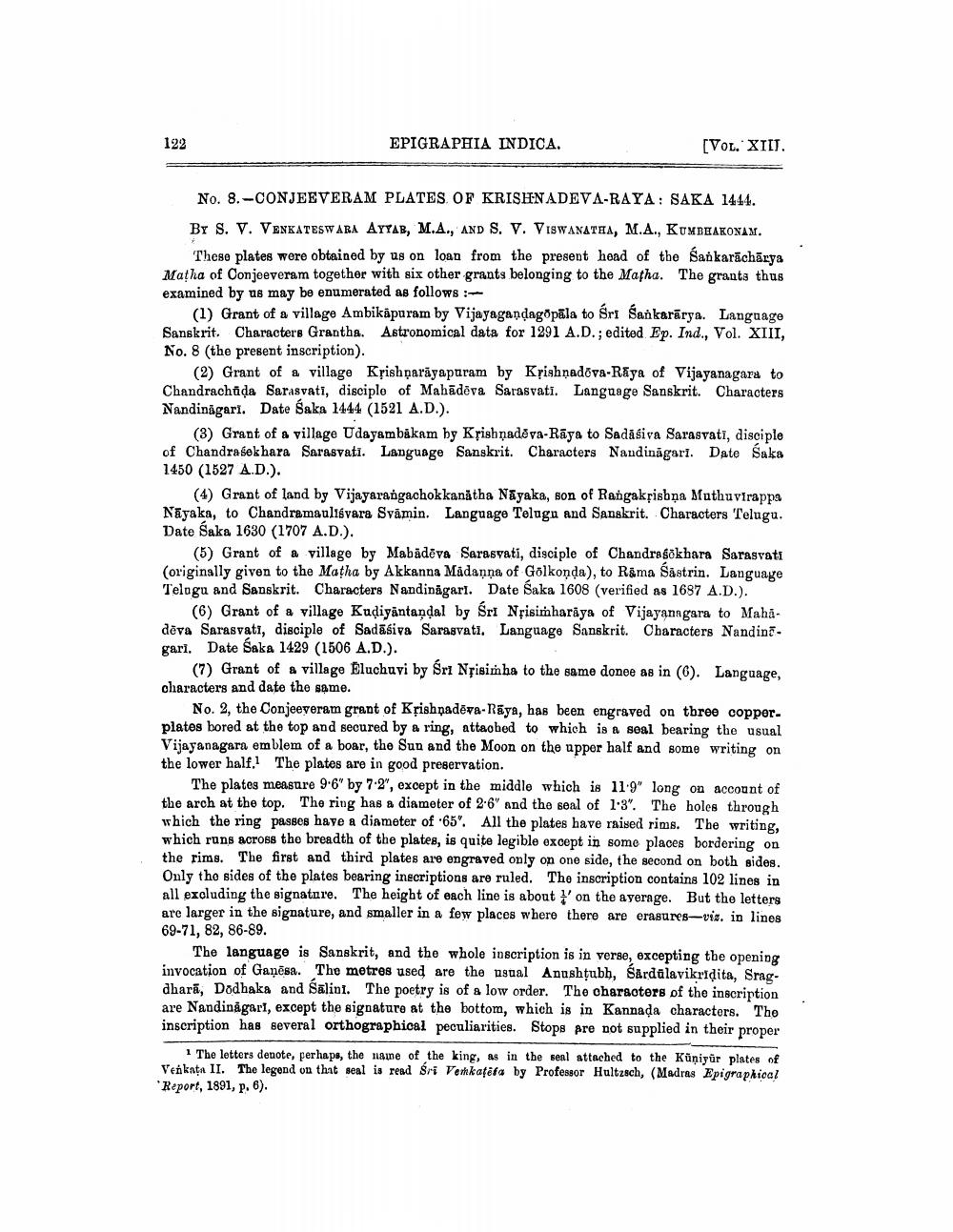________________
122
EPIGRAPHIA INDICA.
[VOL. XIII.
No. 8.-CONJEEVERAM PLATES OF KRISHNADEVA-RAYA: SAKA 1444. Br S. V. VENKATESWARA AYYAB, M.A., AND S. V. VISWANATHA, M.A., KUMBHAKONAM.
These plates were obtained by us on loan from the present head of the Sankaracharya Matha of Conjeeveram together with six other grants belonging to the Matha. The grants thus examined by us may be enumerated as follows:
(1) Grant of a village Ambikapuram by Vijayagaṇḍagopala to Sri Sankarārya. Language Sanskrit. Characters Grantha. Astronomical data for 1291 A.D.; edited Ep. Ind., Vol. XIII, No. 8 (the present inscription).
(2) Grant of a village Krishnarayapuram by Krishnadeva-Raya of Vijayanagara to Chandrachuḍa Sarasvati, disciple of Mahādēva Sarasvati. Language Sanskrit. Characters Nandinagari. Date Saka 1444 (1521 A.D.).
(3) Grant of a village Udayambakam by Krishnadeva-Raya to Sadasiva Sarasvati, disciple of Chandrasekhara Sarasvati. Language Sanskrit. Characters Naudinagari. Date Saka 1450 (1527 A.D.).
(4) Grant of land by Vijayarangachokkanatha Nayaka, son of Rangakrishna Muthuvirappa Nayaka, to Chandramauliévara Svamin. Language Telugu and Sanskrit. Characters Telugu. Date Saka 1630 (1707 A.D.).
(5) Grant of a village by Mahadeva Sarasvati, disciple of Chandrasekhara Sarasvati (originally given to the Matha by Akkanna Mädanna of Golkonda), to Rama Sastrin. Language Telugu and Sanskrit. Characters Nandinagari. Date Saka 1608 (verified as 1687 A.D.).
(6) Grant of a village Kudiyantanḍal by Sri Nrisimharaya of Vijayanagara to Mahadeva Sarasvati, disciple of Sadasiva Sarasvati. Language Sanskrit. Characters Nandinggari. Date Saka 1429 (1506 A.D.).
(7) Grant of a village Eluchuvi by Sri Nrisimha to the same donee as in (6). Language,
characters and date the same.
No. 2, the Conjeeveram grant of Krishnadeva-Raya, has been engraved on three copperplates bored at the top and secured by a ring, attached to which is a seal bearing the usual Vijayanagara emblem of a boar, the Sun and the Moon on the upper half and some writing on the lower half. The plates are in good preservation.
The plates measure 9.6" by 7.2", except in the middle which is 119" long on account of the arch at the top. The ring has a diameter of 2-6" and the seal of 13". The holes through which the ring passes have a diameter of 65". All the plates have raised rims. The writing, which runs across the breadth of the plates, is quite legible except in some places bordering on the rims. The first and third plates are engraved only on one side, the second on both sides. Only the sides of the plates bearing inscriptions are ruled. The inscription contains 102 lines in all excluding the signature. The height of each line is about on the average. But the letters are larger in the signature, and smaller in a few places where there are erasures-viz. in lines 69-71, 82, 86-89.
The language is Sanskrit, and the whole inscription is in verse, excepting the opening invocation of Ganesa. The metres used are the usual Anushṭubb, Sardalavikridita, Sragdhara, Dodhaka and Salini. The poetry is of a low order. The characters of the inscription are Nandinagari, except the signature at the bottom, which is in Kannada characters. The inscription has several orthographical peculiarities. Stops are not supplied in their proper
1 The letters denote, perhaps, the name of the king, as in the seal attached to the Küniyür plates of Venkata II. The legend on that seal is read Sri Venkatesa by Professor Hultzsch, (Madras Epigraphical Report, 1891, p. 6).




